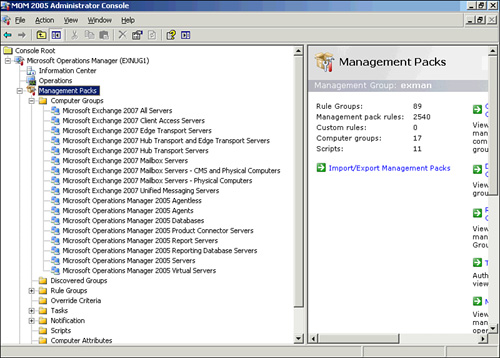It
is beyond the scope of this book to venture into the world of Microsoft
Operations Manager 2005. It’s an event and performance management
system that watches event logs and does proactive alerting and
reporting. It looks at a baseline and can perform trend analysis.
Note
MOM
2005, although widely used in the workplace, has been replaced by
Systems Center Operations Manager (SCOM) 2007. You can continue to use
MOM if that is what is used in your environment, and Microsoft provides
Management Packs for its continued use. However, if you do not have MOM
in place, you should consider implementing SCOM, which also has
management packs for Exchange 2007 SP1.
In
terms of Exchange 2007, it can identify peak workload hours, detect
abnormal behavior, and provide detailed reports regarding your
environment.
To get
MOM up and running, you need to install the SQL Server first and then
the MOM database. Finally, to extend the functionality of MOM to give
you the Exchange features, you need to install the Exchange Management
Pack.
PS Note
The Exchange Management Pack takes advantage of the Test
cmdlets (which we discuss in detail toward the end of this chapter),
returns the results to MOM, and presents them in an easy-to-read report.
You
need to install Internal Agents on the internal Exchange servers, such
as the Hub Transport, Client Access, Unified Messaging, and Mailbox
servers. Or, you can install External Agents to work with the Edge
Transport servers.
You
can download the management pack from Microsoft; it’s a free download.
It comes in as an MSI file and you have to open it and extract the
files first. If you have MOM already up and running, you can install a
management pack by performing the following:
1. | Open
the MOM 2005 Administrator Console. Click Start, All Programs,
Microsoft Operations Manager 2005, and then click Administrator Console.
|
2. | From
the Navigation pane, you can see the Management Packs section. If you
expand this and select Computer Groups, you see a variety of different
MOM options, but none relate to Exchange 2007.
|
3. | Click Management Packs.
|
4. | Right-click Management Packs, and select Import/Export Management Pack to open the wizard. Click Next.
|
5. | You can choose to import or export management packs. Select the radio button to import, and then click Next.
|
6. | You
can choose where the pack is located (which is where you extracted the
files), and you can choose the type of report you want to perform. In
this case, select Import Management Packs only. Click Next.
|
7. | You
are asked to select the management pack, and then you have to select
import options. Choose either Update Existing Management Pack. Custom
Rules, Enabled/Disabled Settings, and Company Knowledge Will Be
Retained or Replace Existing Management Pack.
|
8. | You can choose to back up the existing management pack and browse for a location. Then click Next.
|
9. | You
are shown the Import Status as it imports the information. When you
return to the console and look at the Computer Groups again, you can
see in Figure 8 that you now have a lot of Exchange 2007 options.

|
Next,
you install agents. You can do that from the wizards provided in the
Administrator Console for internal agents (for the Hub, CAS, MB, and UM
roles). However, for your Edge transport servers, you have to install
the agents manually.